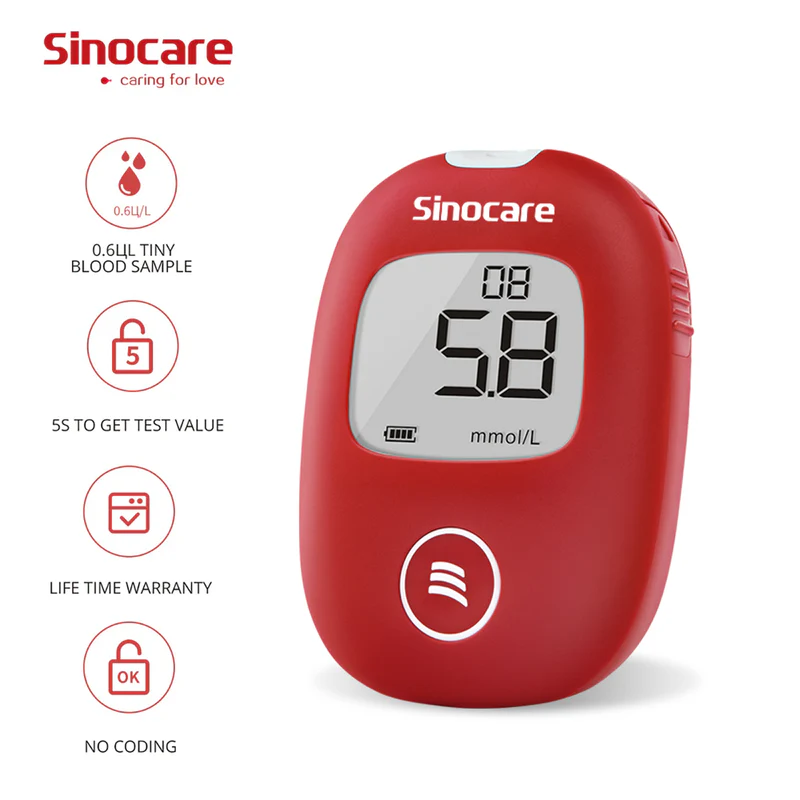Choosing between a blood sugar monitor (also called a blood glucose meter) and a Continuous Glucose Monitor (CGM) is a key decision for diabetes management, requiring evaluation of usability—especially how to use blood glucose meter effectively—and alignment with individual health routines. Both tools serve critical roles in tracking glucose levels, but the blood sugar monitor’s simplicity in how to use blood glucose meter and accessibility makes it a go-to option for many users, while CGM offers continuous data for specific needs.
Usage Method and Operation Difficulty: The Simplicity of How to Use Blood Glucose Meter
A blood sugar monitor relies on fingertip blood sampling, and how to use blood glucose meter involves straightforward steps: pricking the finger with a lancet, applying a small blood sample to a test strip, and inserting the strip into the device to get results within seconds . This process requires minimal training, making the blood sugar monitor ideal for users of all ages, including seniors or those new to glucose monitoring. In contrast, CGM uses a subcutaneous sensor that needs to be inserted under the skin and paired with a receiver, involving more complex setup and maintenance . The blood sugar monitor’s ease of use—rooted in how to use blood glucose meter simply—eliminates the need for sensor insertion or calibration (for most models), supporting consistent daily testing.
Data Characteristics: Spot Readings vs Continuous Tracking for Blood Sugar Monitor Users
A blood sugar monitor provides precise spot glucose readings, and the reliability of these results depends on mastering how to use blood glucose meter correctly—such as ensuring adequate blood volume on the test strip and proper storage of supplies . These instant readings are perfect for checking glucose levels before meals, after exercise, or when symptoms arise. CGM, by contrast, records glucose levels every 1–5 minutes from interstitial fluid, offering continuous trends and alerts for highs or lows . However, the blood sugar monitor remains valuable even for CGM users, as it can verify CGM data and requires no lag time (unlike CGM’s 5–10 minute delay) . For many, the blood sugar monitor’s direct, immediate data—paired with the simplicity of how to use blood glucose meter—meets daily monitoring needs effectively.
Applicable Scenarios: Matching Blood Sugar Monitor to Lifestyle Needs
The home blood glucose meter excels in scenarios where portability and quick testing are essential, as how to use blood glucose meter requires only the device, test strips, and a lancet—easy to carry while traveling, working, or dining out . It is also a cost-effective choice for users with stable diabetes who need regular but not continuous monitoring. CGM is better suited for those with frequent blood sugar fluctuations, type 1 diabetes, or insulin-dependent type 2 diabetes, as it captures overnight changes and asymptomatic highs/lows . However, the blood sugar monitor’s lower upfront and ongoing costs (no recurring sensor fees) and the simplicity of how to use blood glucose meter make it more accessible for users seeking basic, reliable monitoring.
Choosing Based on Individual Needs: The Value of a User-Friendly Blood Sugar Monitor
The “better” monitoring tool depends on glucose management goals, lifestyle, and comfort with technology. For users prioritizing simplicity, affordability, and immediate results, the home blood glucose meter stands out—especially when paired with mastery of how to use blood glucose meter. The Sinocare Safe AQ Smart Blood Sugar Monitor is an excellent choice: it features code-free strips, 5s test time, and just 0.6μL blood sample, with FAD-GDH strips resisting common interferences, delivering reliable results that align with easy, effective diabetes care.


